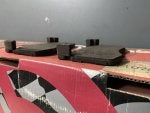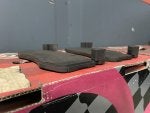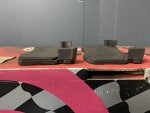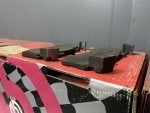I wanted to talk about why you should regularly keep an eye on your pads yourself, instead of waiting for the warning to come on, especially when you're below 1/3 thickness. In fact, you should start considering booking an appointment from as early as that, and I'll tell you why. You may be aware that we only have one sensor, located into the right hand side caliper, don't know if it's the other one in the UK but anyway doesn't matter it's still one caliper, and actually it's placed so that it can detect wear on only one pad. I don't know why we don't have one sensor per pad, is it down to costs, more complex system I have no idea, but what that means is that you have another three pads wearing out at the same time and you have no way of knowing whether they are at the same wear level, better or worse. And make no mistake, they never wear at the exact same pace. Now, obviously that one sensor is supposed to be designed and placed in a way to account for minor wear difference between the pads, letting you know before the thinnest of them all starts scrapping on your disc. But, could minor be enough? With no further ado, let me show you what could happen if you religiously relied on the warning.
Here are my left hand side pads, outer-inner from left to right. Nothing too worrisome.
![]()
![]()
![]()
And here are my right hand side pads, again outer-inner. How do you like my inner?
![]()
![]()
![]()
You would think I at least got the warning, right? You would be wrong, still no warning.
But let me give you the backstory. So I was happily driving around town at 80kph until I started hearing a faint grinding noise when braking at low speeds, like in the last few meters before the stop light. Pulled over, checked pads, well, as you can see in the pics (remember I could only take a look at the outer pad), nothing seemed alarming although I knew they were due to be changed soon (reason why I had already purchased them and was just waiting for the warning). Both discs also had a circular marker-thick pad mark at about the center of the disc, which happens often when you stop aggressively a few times (which I did the day before that) and then when you brake normally, the pad gradually wipes it off. On my way home, I had the noise when stopping at every stop light and then, in the last 5-10 minutes I noticed it went away. Parked the car and went to check again. Mark was gone.
Next morning I called my brake mechanic who's also the owner of the business, whom I've known for a decade, he's the pure definition of professionalism, and after describing the issue he said, first of all I should never rely on the warning and what I was hearing could've been the pad grinding on itself, meaning it could've been grinding on what it had left on the disc (the marker line). Which isn't a bad thing, but a pad that is too worn, can often develop spots with harsh surface and that can pair with the marks on the disc and produce horrible noises. Although that may not necessarily damage the disc, over time it can cause white spots and slight circular grooves which you can feel if you run your finger over it. But either way, he said we'd better get them checked and probably replaced. I said oh great I happen to have the pads over here, along with a new sensor, and he said to give him a call in a couple of hours cause he may be able to squeeze me into his schedule, and he did. In fact he worked an extra two hours after closing hours, just for me.
Here's a couple more pics, to give you an idea of what a pad's surface can turn into when it goes way too thin.
This is the left-hand side (outer-inner). Slight discoloration on the inner.
![]()
But take a look at the right-hand side. Zoom in if you can't see it. Now this is not something you want on your disc.
![]()
Now I'm gonna show you what else was slightly grinding.
These are my discs after I got the pads replaced. Notice the circumference of the discs? See how the right-hand side looks cleaner while the left hand-side more brownish? Well this is rust, completely normal, but why's the right disc clean?
![]()
![]()
Because, if you go back to the right hand-side pads pic, especially the middle one, you'll see the pad's case or whatever you wanna call it, I don't even know what it's called, being a hair away from the pad's surface. Now you can imagine, a disc that is already at 50% thickness itself, has a circumference that sticks out further. And that pad's case was slightly "cleaning" the disc's circumference, hence why it's clean from rust, while the other one isn't.
Of course nothing to worry about, nothing bad happened to the disc, it will quickly develop the same rust as before, as for the grooves that you can feel with your finger (it's those very thin marks, like those found on vinyl records), they have already been cleared by the new pads after having done 200km since. I'll try to remember and take another pic for you tomorrow, so you can see they now look almost mirror-like.
Alright, so, listen, just don't wait for the warning, it's bad! At least as far as the A45s is concerned. There was another Mercedes, some C class I believe, just before getting the car on the ramps, that was also in for new pads, and my mechanic showed me what all his four pads looked like. Well, absolutely nothing as scary-close as ours, and he got his warning. AMG has literally not allowed nearly any pad margin in our cars, despite what dealerships will tell you (the usual 1500km after warning).
Take pad wear into your own hands.
Here are my left hand side pads, outer-inner from left to right. Nothing too worrisome.



And here are my right hand side pads, again outer-inner. How do you like my inner?



You would think I at least got the warning, right? You would be wrong, still no warning.
But let me give you the backstory. So I was happily driving around town at 80kph until I started hearing a faint grinding noise when braking at low speeds, like in the last few meters before the stop light. Pulled over, checked pads, well, as you can see in the pics (remember I could only take a look at the outer pad), nothing seemed alarming although I knew they were due to be changed soon (reason why I had already purchased them and was just waiting for the warning). Both discs also had a circular marker-thick pad mark at about the center of the disc, which happens often when you stop aggressively a few times (which I did the day before that) and then when you brake normally, the pad gradually wipes it off. On my way home, I had the noise when stopping at every stop light and then, in the last 5-10 minutes I noticed it went away. Parked the car and went to check again. Mark was gone.
Next morning I called my brake mechanic who's also the owner of the business, whom I've known for a decade, he's the pure definition of professionalism, and after describing the issue he said, first of all I should never rely on the warning and what I was hearing could've been the pad grinding on itself, meaning it could've been grinding on what it had left on the disc (the marker line). Which isn't a bad thing, but a pad that is too worn, can often develop spots with harsh surface and that can pair with the marks on the disc and produce horrible noises. Although that may not necessarily damage the disc, over time it can cause white spots and slight circular grooves which you can feel if you run your finger over it. But either way, he said we'd better get them checked and probably replaced. I said oh great I happen to have the pads over here, along with a new sensor, and he said to give him a call in a couple of hours cause he may be able to squeeze me into his schedule, and he did. In fact he worked an extra two hours after closing hours, just for me.
Here's a couple more pics, to give you an idea of what a pad's surface can turn into when it goes way too thin.
This is the left-hand side (outer-inner). Slight discoloration on the inner.

But take a look at the right-hand side. Zoom in if you can't see it. Now this is not something you want on your disc.

Now I'm gonna show you what else was slightly grinding.
These are my discs after I got the pads replaced. Notice the circumference of the discs? See how the right-hand side looks cleaner while the left hand-side more brownish? Well this is rust, completely normal, but why's the right disc clean?


Because, if you go back to the right hand-side pads pic, especially the middle one, you'll see the pad's case or whatever you wanna call it, I don't even know what it's called, being a hair away from the pad's surface. Now you can imagine, a disc that is already at 50% thickness itself, has a circumference that sticks out further. And that pad's case was slightly "cleaning" the disc's circumference, hence why it's clean from rust, while the other one isn't.
Of course nothing to worry about, nothing bad happened to the disc, it will quickly develop the same rust as before, as for the grooves that you can feel with your finger (it's those very thin marks, like those found on vinyl records), they have already been cleared by the new pads after having done 200km since. I'll try to remember and take another pic for you tomorrow, so you can see they now look almost mirror-like.
Alright, so, listen, just don't wait for the warning, it's bad! At least as far as the A45s is concerned. There was another Mercedes, some C class I believe, just before getting the car on the ramps, that was also in for new pads, and my mechanic showed me what all his four pads looked like. Well, absolutely nothing as scary-close as ours, and he got his warning. AMG has literally not allowed nearly any pad margin in our cars, despite what dealerships will tell you (the usual 1500km after warning).
Take pad wear into your own hands.





